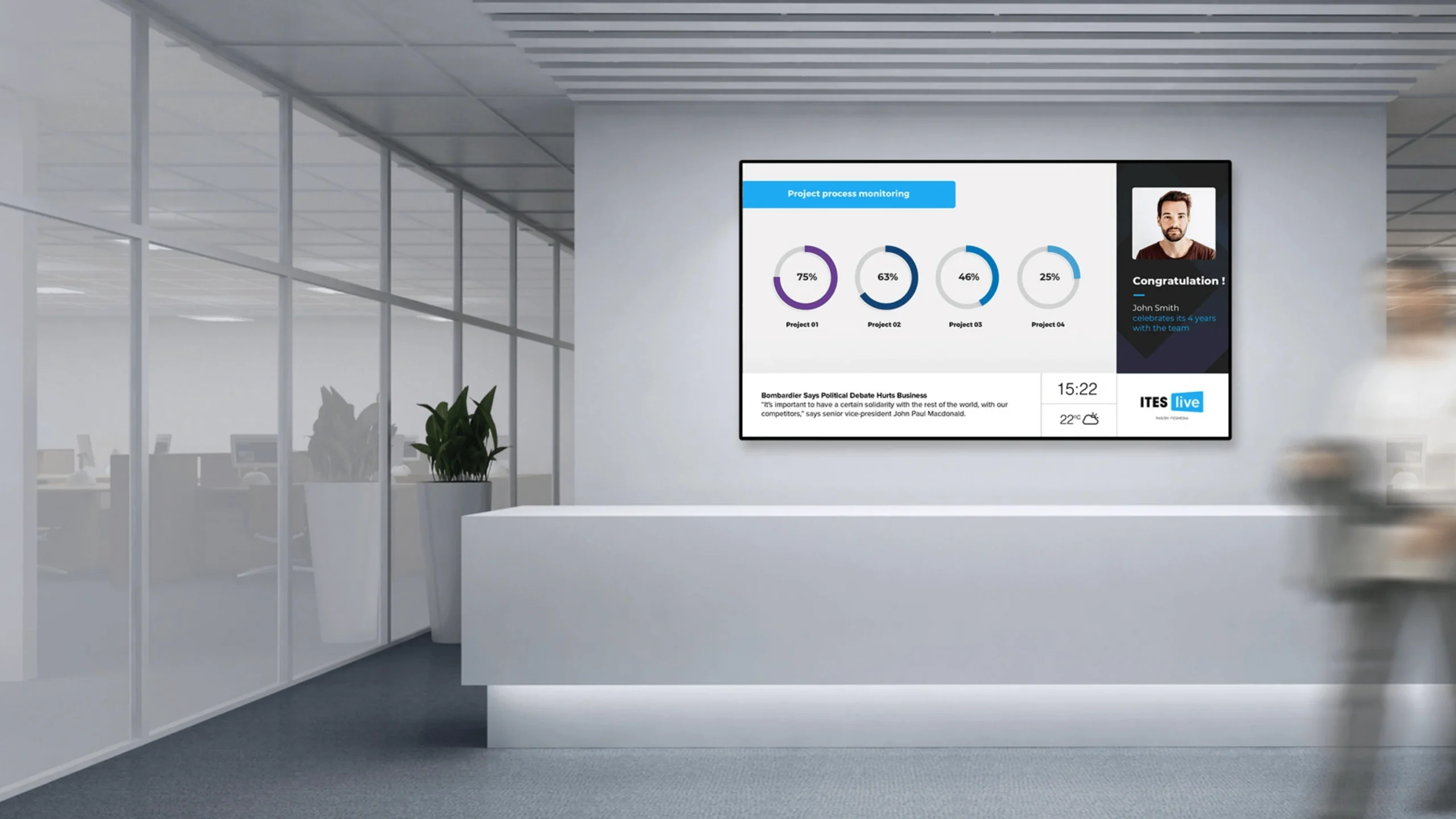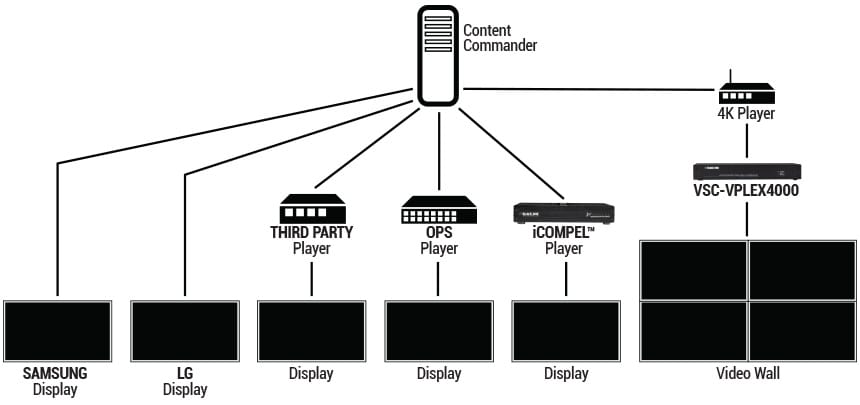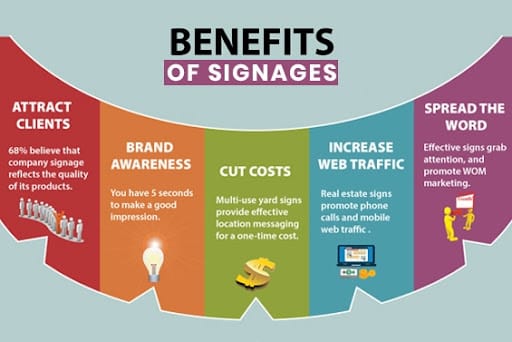Businesses have changed the way they communicate with the audience and digital signage became a vital part of this change. Although still in use, traditional static signage has increasingly been replaced with dynamic, digital displays that offer real-time updates, interactive visual experiences, and more. The reasons behind this shift are the need to have more flexible, cost-effective, and impactful communication tools that respond to changing consumer behaviors and business demands.
Digital signage is the process of using advanced display technology, digital signage software, and cloud-based content management systems to enable business companies to be in charge of and update digital content on displays easily. Since printed banners or posters are time and resource-consuming, digital signage is a good way to distribute information on different locations at once. Such as AI-powered analytics of real-time substance calendaring, businesses can now capitalize on such data-driven perceptions to the viewpoint of their customers, what needs to improve, and enhance their marketing methodologies.
Digital signage is used to communicate with the target audience in retail, hospitality, healthcare, education, and corporate settings. An example would be restaurant digital signage, which has changed the way eateries present their menus, advertise their promotions, and enable customers to order digitally via interactive digital menu boards. In the same way, internal communications are streamlined in corporate offices; in healthcare facilities, updates such as important information and patient information are posted.
What Is Digital Signage?
At its core, digital signage refers to the use of digital displays to showcase multimedia content such as advertisements, menus, announcements, and real-time updates. Strategic placement of these displays occurs in public spaces, retail stores, restaurants, hospitals, and corporate offices as a means of attracting attention, informing customers, and driving engagement.
The various forms of digital signage include LED displays, LCD screens, interactive kiosks, and a large video wall. Such digital solutions can present static images, videos, animations, real-time information, etc, presenting messages adapted to the needs of the business. Cloud-based digital signage software enables companies to control multiple screens from now on and to navigate and schedule the content with precision at the forefront of manual updates of each display.
One of the ways by which digital signage is a valued commodity in different sectors is because it is versatile. Digital displays that promote new arrivals and special offers are the retail’s use of digital display. It’s the same in store for restaurants’ use of digital menu boards that display changing food options and pricing updates as well as limited-time deals. Digital signage helps to communicate meeting schedules, company updates and productivity metrics in a corporate setup. Hospitals and clinics use digital signage for wayfinding, patient education, and emergency announcements that important information comes to the right people at the right time.
Digital signage is one of the advantages that increases brand visibility and customer engagement. While cranky billboards have no such dynamism, digital signage does, as it allows for dynamic motion graphics, interactivity, and targeted content delivery to get people hooked. In order to improve communication and efficiency, digital signage is an advanced solution that businesses can use to accomplish their goals of raising sales, informing customers, or creating immersive brand experiences.
Key Components of Digital Signage
In order for digital signage to work correctly, several required key components need to work in concert. All these elements guarantee smooth delivery of the content, real-time updates, and a good viewing experience for the audience.
Display Screens
The display screen is the most visible part of any digital signage system. There are a few options when it comes to businesses, such as LED, LCD, interactive kiosks, and extensive video walls. Digital menu boards could be the choice for restaurants. In contrast, retail stores can use large LED screens for promotional content, depending on the specific business requirements.
Media Players
The media player is the bridge between the CMS and the display screen. It deals with the digital content and makes sure that the playback is as smooth as possible. Standalone external devices, embedded players in smart TVs, and cloud-based solutions are some of the forms of media players. Optimal performance and compatibility with the business’s digital signage software can be ensured by choosing the right media player.
Digital Signage Software
Digital signage software is at the heart of digital signage operations because it facilitates content management, scheduling and remote monitoring purposes. Most modern digital signage platforms come with a cloud-based CMS with AI-powered intelligent analytics, which helps businesses track user engagement and make necessary changes to their content strategy.
Internet & Network Connectivity
Content distribution requires reliable Wi-Fi, Ethernet, or offline USB-based content updates. For their part, cloud-based digital signage solutions frequently utilize fast internet connections to grant real-time content updates, but some of them do support offline functions for distant sites.
Content Management System (CMS)
The primary purpose of a CMS is to offer businesses a place where they can upload, organize,e and schedule content to be displayed on various devices. This guarantees that promotional messages, advertisements, or announcements are displayed at the correct time and place. It is worth noting that advanced CMS platforms attach the options for automated scheduling, drag-and-drop content creation, and performance analytics.
Power Supply & Energy Efficiency
Businesses need to keep digital signage running smoothly and to do so; power efficiency must be considered. For this, many modern digital displays possess energy-saving mechanisms of adjusting brightness according to ambient lighting conditions such that there is lower power consumption and yet good visibility.
How Digital Signage Works: Step-by-Step Process
The workflow of a digital signage system is also essential to understand in order to implement and optimize the strategy of content delivery. Digital signage works in the following way, step by step as follows:
Step 1: Content Creation
The first thing to do is to create engaging multimedia content. Graphics, videos, animations, or interactive elements are made by businesses based on their audience. Moreover, digital signage software that allows for simple drag-and-drop editors along with AI-enabled templates is present in many companies.
Step 2: Uploading & Scheduling
The content is designed and uploaded to a cloud-based content management system (CMS). Content is scheduled on peak hours, customer demographics, and promotional campaigns. Through automated scheduling, different content can appear on the phone at other times of the day without manual treatment.
Step 3: Content Delivery
The media player then processes the data from the CMS and sends it to the display screen. The media player is capable of playing all multimedia elements smoothly, whether the system is connected via Wi-Fi, Ethernet, or offline storage.
Step 4: Display & Interaction
When content reaches the display screen, it is displayed to the customers by high resolution visual, motion graphics, and interactive elements. Many businesses develop touchscreen technology for users to interact with digital menus, directories, or product catalogs.
Step 5: Real-Time Monitoring & Updates
One of the main advantages of digital signage, it allows for monitoring screen performance and updating content remotely. It will enable businesses to keep track of engagement metrics, find out what kind of content is more prevalent among its users, and reshuffle their digital strategy. Cloud-based digital signage software solutions may have real-time analytics so that businesses can get the maximum out of their advertising and use it to enhance customer engagement.
Applications of Digital Signage Across Industries
There has been a wide use of digital signage across all industries to engage customers in various ways, streamline operations, and enhance communication. With digital signage software and the use of interactive displays and cloud-based content management, businesses can easily manage content as well as supply real-time updates.
Retail Digital Signage: Enhancing Shopping Experiences
Retail stores use digital signage to build up an engaging shopping environment. Digital signage helps to display seasonal promotions, new arrivals, and fresh stores. It presents real-time pricing to make customers interact with a brand. Customers are empowered to find products, browse catalogs, and receive recommended products from interactive kiosks. Moreover, businesses can also utilize AI-based analytics and tailor or offer promotions and other business advantages based on customer behavior, which increases sales opportunities.
Restaurant Digital Signage & Menu Boards: Streamlining Operations
Digital menu boards are proving an excellent help for restaurants as they provide benefits way beyond replacing traditional printed menus with simultaneous dynamic and customizable displays. The digital solutions of these startups make the ordering process more straightforward, less time-consuming, and more effective in terms of customer satisfaction. The restaurant’s digital signage software, based on the cloud, provides the ability to update menu items, pricing items, and promotions instantly in multiple locations for consistency. Self-order is also available via interactive displays, reducing staff dependency and speeding up order time.
Corporate Digital Signage: Improving Internal Communication
Digital signage is used by businesses and corporate offices to streamline their internal communication. Digital displays are used for displaying meeting schedules and productivity dashboards, broadcasting company updates and employee recognition programs, and more to improve workplace engagement. Corporate digital signage also takes part in branding, updating company culture, and notifying critical information in a big office space or conference hall.
Healthcare Digital Signage: Enhancing Patient Experience
Digital signage in hospitals and clinics allows them to share critical patient information, reduce the fear of waiting, and make them another form of navigation. In the waiting areas, health tips, appointment schedules, etc., on health notifications in emergencies are displayed through digital screens, and patients are assisted with self-checks, wayfinding, and appointment confirmations through interactive kiosks. Real-time updates mean that patient communication will be accurate by automatically integrating with healthcare management systems.
Education Digital Signage: Transforming Campus Communication
Digital Signage plays a vital role in educational institutions to make students, staff, and visitors informed. On the other hand, large digital displays located on different campuses present vital messages, events, and up-to-the-moment news precisely as they take place. Interactive schools and universities also use interactive digital bulletin boards to assist in wayfinding, presenting class schedules, and serving safety alerts. Digital signage in education presents seamless communication on large campuses and better the student experience in general.
Benefits of Digital Signage for Businesses
Digital signage is a whole new way of promoting your business, and it comes with an array of benefits, from enhancing your customer engagement to even saving you a lot on cost as well as boosting sales. Businesses that implement their software can benefit from more efficient, engaging, and enjoyable means to meet with the audience.
Enhanced Customer Engagement
Digital signage is one of the main advantages because it manages to attract attention and hold customers. Whereas static signs are static, they are not; digital displays are motion graphics, videos, and live content that attract the viewers and help to retain the message. In addition, interactive signage enhances engagement through the ability of customers to browse product details, current promotions, and even personalized recommendations.
Less Advertising Expenses and Cost Savings
For traditional print advertising, there are recurring costs of reprints, distribution, and replacement advertising. Unlike this, digital signage cuts out these costs by introducing a one-time investment with long-term savings. Real-time update of content by businesses eliminates the refreshing of the new printed copies and savings in the total marketing costs.
Remote Content Management with Cloud-Based Solutions
Now, with the cloud-based digital signage software, businesses can control a number of screens at different places, all from a single platform. This is a particularly useful feature if you have a franchise business, retail chain, or corporate office, where up-to-date brand consistency is critical. It allows for remote scheduling, updating, and monitoring of signage for efficiency and to save valuable time.
Boosting Sales and Revenue
According to research, digital signage has been shown to impact customer buying decisions and thus result in higher revenue. Here, dynamic promotions, upselling opportunities, and AI-driven recommendations are pushed on the customers to explore more products and services. Bestselling items can be highlighted in retail and restaurant environments, or a limited-time discount offering will increase conversions extremely well in retail and restaurant environments.
Improved Brand Awareness and Recognition
Adding high-quality visuals, branding elements, and great stories will help businesses solidify a brand identity and make it known to users. Both a restaurant flaunting its signature dishes and a corporate office can promote its achievements through digital signage, as the brand messaging is maintained and impactful.
Selecting the best Digital Signage Company in the USA
Picking the right digital signage provider is very important for businesses who want to invest in a solution that is scalable, efficient, with a high-quality of digital signage. Many companies provide various services, so it is necessary to think about important things before making a choice.
Factors to Consider When Selecting a Digital Signage Company
- The digital signage system is built on the software side. The ideal company will provide cloud-based content management, real-time updates, etc., with the power of AI automation.
- Digital signage technology is available in different solutions and designs that offer quality and practical hardware compatibility to display your message to your target market. A top provider will have custom hardware solutions for different types of different industries, like restaurant digital signage, retail displays, and interactive kiosks.
- Every business has different needs, customization & scalability. The digital signage company should be able to provide customizable solutions that can grow with multiple locations without affecting performance.
- A reliable provider should provide 24/7 support, software updates, and troubleshooting to avoid downtime. Valuable as well are maintenance services that include: remote monitoring and automatic error detection.
On the one hand, if we compare Software, Hardware, and AI, among them there is no winner. In order to compare digital signage companies, businesses should compare software flexibility, AI-driven insights, and ease of integration. One of the best digital signage providers utilizes AI-powered analytics, which enables you to track audience engagement, customize the content,t and engage with the customers. Automated content scheduling and data-driven recommendations are offered by companies that ensure that businesses achieve their highest return on investment from the former.
Future Trends in Digital Signage Technology
The consideration of digital signage as an industry is ongoing, recognizing the means of improving the efficiency and extent of personalization constantly while keeping the consideration of more efficient resources. The following are some of the most anticipated of the trends of the future of digital signage:
AI-Powered Digital Signage for Personalized Experiences
Through the use of artificial intelligence (AI) it is changing the digital signage by way of recommending content based on live data. The AI will realize customer behavior, demographics, and buying patterns to present applicable promotions or product proposals. AI-powered analytics are being widely accepted as a solution by retailers, restaurants, and corporate spaces to enhance customer engagement and to adjust marketing strategies.
Touchscreen & Interactive Displays for Engagement
To meet the increasing demands of customers who now seek more engaging experiences, interactive digital signage is a must-do in the retail store, restaurant and service industry setting. Users browse products and order without human assistance and access details from the product, all without any human assistance. Interactive displays are a fantastic example of how they can improve customer service and enterprise operation with self-ordering kiosks in restaurants and wayfinding screens in malls and airports, respectively.
Integration with Mobile & IoT for Connected Experiences
The advent of the modern wave of digital signage boils down to mobile integration and the Internet of Things (IoT) technology. Nowadays, QR codes, mobile apps, and Bluetooth connectivity are being used by businesses to provide seamless screen and personal device interactions. Digital menus can now be scanned, mobile discounts can be given, and customers can interact with personalized ads all from their smartphones. Moreover, IoT-enabled signage systems are capable of automation of real-time content updates based on environmental conditions, sales data or traffic flow.
Eco-Friendly & Energy-Efficient Digital Signage
The fact is that businesses investing in digital signage solutions are making it a top priority: Sustainability. Companies are using LED displays with less energy consumption and solar-powered signage in order to reduce their environmental impact. Such modern digital signage solutions also contain adaptive brightness settings, which automatically change according to the ambient lighting but use energy saving wisely while keeping the screen clearly visible. Therefore, it is expected that energy-efficient signage will be the industry standard that is driven by sustainability trends that continue to influence business practices.
Frequently Asked Questions (FAQs)
What is digital signage software?
Digital signage software is a platform used for managing scheduling displaying of multimedia content in digital signs.
What is a digital menu board?
Digital menu board is an electronic display which is used by the restaurants to put the details such as information regarding the menu items, and other promotions and prices.
How much does digital signage cost?
The cost of digital signage is based on the type of screen, media player and software subscriptions. Entry level setups are in the 100’s while advanced solutions are in the thousands.
Which industries benefit the most from digital signage?
Digital signage is used to improve communication and engagement in retail, hospitality, healthcare, corporate, education and transportation industries.
Which one is the best digital signage company in the USA?
What makes the best digital signage company differs from one to another, from software features, customer support to industry specialization. Some popular providers include BrightSign, NoviSign, Scala, etc.
Is the installation of digital signage a difficult task?
Digital signage systems are mostly plug-and-play. However, professional installation might be required depending on the complexity of the setup.
Can digital signage work without an internet connection?
Some digital signage systems can play offline with USB or internal storage.
How does digital signage enhance customer experience?
Digital signage provides customer satisfaction by providing real-time updates, interactive content personalized messages, & etc.
Final Thoughts
Digital signage software and digital menu boards have brought about changes in the way businesses interact with their customers and manage their branding and the way they operate. Digital signage offers a low-cost, scalable, engaging communication tool for business that improves customer interaction and increases business efficiency, whether in retail, restaurants, healthcare, corporate space, or education.
As AI-powered analytics, cloud-based content management, and interactive touchscreen technology further progress, digital signage has become. It continues to evolve as a modern means by which businesses can connect and personalize messages that, too, are presented to their audiences. With digital signage, investing will guarantee real-time content updates, hassle-free scalability, and the potential to enhance client engagement; registering is a must-have for businesses making efforts to be on top in a very competitive market.
🚀 Upgrade your business with Nento Digital Signage!
Do you require a powerful yet easy-to-manage, scalable digital signage solution? At Nento Digital Signage, cutting-edge technology, AI-based analytics, and cloud-based management work towards maximizing a business’s digital display strategy.
👉 Explore Nento Digital Signage today and revolutionize your brand communication!









